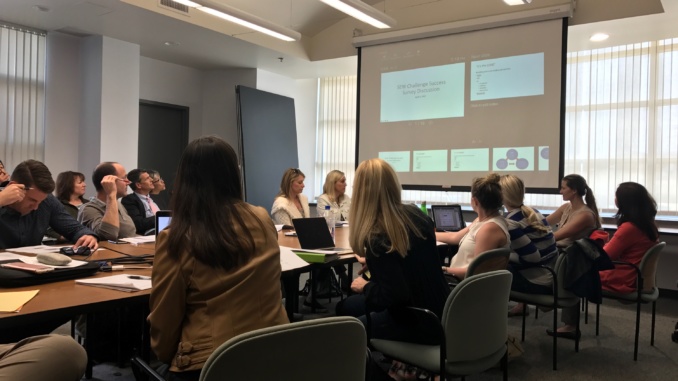
By Naomi Tsuang
Online News Editor
Mira Costa’s Social and Emotional Wellness Committee, a group of students, parents and Costa staff, analyzed and discussed the results from the Challenge Success survey at its April 3 meeting, in order to analyze Costa students’ perspectives on stress.
The committee was created in 2015 in order to assess the school climate at Costa and to identify the root causes of student stress. Since it was created, it has worked with Challenge Success, a Stanford University research organization that aims to create a more balanced and academically fulfilling life for high school students. Students took Challenge Success’s survey on Feb. 1 that measured their perspectives on academics, athletics, extracurriculars and college admissions demands.
“There are many ways to address load across many constituencies,” SEW committee member Ellen Rosenberg said. “Load needs to be addressed across the board. It is not a teacher problem, it is not a student problem and it’s not a parent problem; it’s a pervasive problem throughout the system, creating many symptoms that are popping up.”
Approximately 2,116 Costa students took the Challenge Success survey, which is approximately 90% of the student body, according to Challenge Success. The survey results reveal students’ perspectives on multiple topics, including the amount of homework that they complete each school night, the average amount of sleep that they receive and which extracurriculars cause the most stress.
Photos: The SEW committee discusses the Challenge Success survey results.
“When you look at the school as a whole, the challenge for us here as it relates to load is differentiating between load and rigor,” Costa Principal Dr. Ben Dale said. “We want to maintain rigor, but we want to address load.”
Survey results indicated that students have an average of 2.75 to 3.38 hours of assigned homework per night with freshman receiving the least amount of homework and juniors receiving the most. Approximately 59% of students who took the survey reported they had too much homework and 38% said they had the right amount.
“One experiment that schools often do is that teachers will have students do a homework assignment in class and it has two benefits, one is that students see how long it takes to do homework undistracted and focused, and teachers get an idea on the range of time of how long [assignments] actually take,” Rosenberg said. “It is an interesting suggestion, so [I hope] some teachers want to experiment and get us feedback.”
Of the 2,116 students who took the survey, 91% are in at least one extracurricular activity either at or outside of Costa. School sports have the highest participation at 58% and the highest level of stress at 35%. Club sports have the fourth highest participation at 35% and the second highest level of stress at 17% and Performing Arts have the fifth highest participation at 27% and the third highest level of stress at 12%.
“Usually extracurriculars are what students love and it is their mental break time,” Rosenberg said. “The difference between school sports and club sports is the optimization and the use of time. Athletes in school sports aren’t always the most productive with their time, whereas when [athletes] are in a club sport they are on task and it just feels like a different level of participation.”
According to the survey results, Costa students receive less sleep than other high schools that also took the survey. The average Costa student receives 6.58 hours of sleep a night, but adolescents are recommended to get 8-10 hours nightly. Also, AP and honor students reported getting less sleep.
In addition, 53% of survey takers reported they have at least one adult at Costa they can go to for help, and freshman had the highest percent. Teachers were cited as the primary sources of support at 55% and counselors second at 24%. However, Challenge Success schools usually have 60% or more students reporting they have an adult on campus to go to if they have problems, according to Challenge Success.
Link: Learn more about the Challenge Success survey.
“When you look at their experience, freshman have a lighter load, a significantly less possibility of having an AP or Honors class and smaller class sizes that make them feel more supported,” Dale said.
Lastly, 82% of students are often or always stressed by school work, 72% said schoolwork often or always keeps them from time with family or friends and 76% said schoolwork often or always keeps them from getting enough sleep. The highest stress related symptoms were exhaustion, difficulty sleeping and headaches.
Link: Learn more about the SEW committee
“Students can’t possibly feel engaged if everything they are feeling is stressed about getting work done and making sure that they are getting a high grade,” Costa Psychologist Janet Allen said. “Students are also inefficiently studying and we need to know how we can help.”
The SEW committee will continue to analyze the survey results and decide on changes necessary to improve the current environment of Costa. In addition, the SEW committee further collaborated with Challenge Success to gain more insight into student stress at a Challenge Success conference in Palo Alto on April 22, Rosenberg said. The next meeting will be on May 15.
“The real work for us as a staff is to figure out how to maintain the level of rigor that is expected from all stakeholders and yet address all of these issues with load,” Dale said.




Leave a Reply